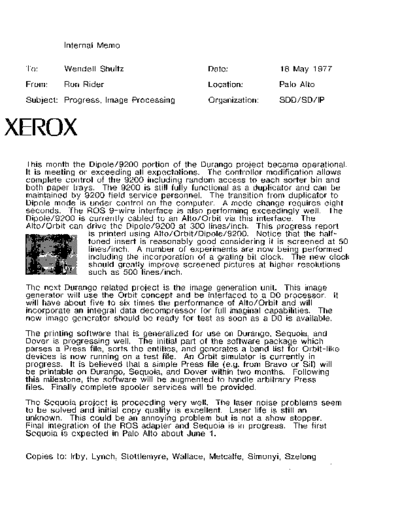Service Manuals, User Guides, Schematic Diagrams or docs for : xerox sdd memos_1977 19770518_Progress_Image_Processing
<< Back | HomeMost service manuals and schematics are PDF files, so You will need Adobre Acrobat Reader to view : Acrobat Download Some of the files are DjVu format. Readers and resources available here : DjVu Resources
For the compressed files, most common are zip and rar. Please, extract files with Your favorite compression software ( WinZip, WinRAR ... ) before viewing. If a document has multiple parts, You should download all, before extracting.
Good luck. Repair on Your own risk. Make sure You know what You are doing.
Image preview - the first page of the document

>> Download 19770518_Progress_Image_Processing documenatation <<
Text preview - extract from the document
Internal Memo
To: Wendell Shultz Date: 18 May 1977
From: Ron Rider Location: Palo Alto
Subject: Progress, Image Processing Organization: SDD/SD/IP
XEROX
This month the Dipole/9200 portion of the Durango project became operational.
It is meeting or exceeding all expectations. The controller modification allows
complete control of the 9200 including random access to each sorter bin and
both paper trays. The 9200 is still fully functional as a duplicator and can be
maintained by 9200 field service personnel. The transition from duplicator to
Dipole mode is under control on the computer. A mode change requires eight
seconds. The ROS 9-wire interface is also performing exceedingly well. The
Dipole/9200 is currently cabled to an Alto/Orbit via this interface. The
Alto/Orbit can drive the Dipole/9200 at 300 lines/inch. This progress report
is printed using Alto/Orbit/Dipole/9200. Notice that the half-
toned insert is reasonably good considering it is screened at 50
lines/inch. A number of experiments are now being performed
including the incorporation of a grating bit clock. The new clock
should greatly improve screened pictures at higher resolutions
such as 500 lines/inch.
The next Durango related project is the image generation unit. This image
generator will use the Orbit concept and be interfaced to a DO processor. It
will have about five to six times the performance of Alto/Orbit and will
incorporate an integral data decompressor for full imaginal capabilities. The
new image generator should be ready for test as soon as a DO is available.
The printing software that is generalized for use on Durango, Sequoia, and
Dover is progressing well. The initial part of the software package which
parses a Press file, sorts the entities, and generates a band list for Orbit-like
devices is now running on a test file. An Orbit simulator is currently in
progress. It is believed that a simple Press file (e.g. from Bravo or Sil) will
be printable on Durango, Sequoia, and Dover within two months. Following
this milestone, the software will be augmented to handle arbitrary Press
files. Finally complete spooler services will be provided.
The Sequoia project is proceeding very well. The laser noise problems seem
to be solved and initial copy quality is excellent. Laser life is still an
unknown. This could be an annoying problem but is not a show stopper.
Final integration of the ROS adapter and Sequoia is in progress. The first
Sequoia is expected in Palo Alto about June 1.
Copies to: Irby, Lynch, Stottlemyre, Wallace, Metcalfe, Simonyi, Szelong
◦ Jabse Service Manual Search 2024 ◦ Jabse Pravopis ◦ onTap.bg ◦ Other service manual resources online : Fixya ◦ eServiceinfo